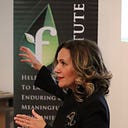Are You A Disruptor?
What my father’s illness taught me about the threat of the high performer
Somewhere in my early twenties, when I was a student in New York, my father, who was living in Spain, was diagnosed with ankylosing spondylitis. The condition was chronic, and judging by the doctor’s comments and the life a friend of the family with the same condition was living, the future didn’t look bright. Overtime pain would definitely increase and mobility would definitely diminish.
My father was not much of a pill popper and I had always had an interest in natural health, so my first instinct was to learn about the condition.
I was thrilled when I came across Norman Cousins ‘Anatomy of an Illness’. Cousins, a doctor himself, had cured his own spondylitis with a combination of massive vitamin C intake, and the power of the mind, something my father definitely had a lot of. He had to read the book! Only one problem, this otherwise well-read man didn’t speak a word of English.
After weeks of hesitation and different calls with Bantam Books assuring me they didn’t have any plans at that point in time to make a Spanish edition, I decided to translate it myself. I didn’t own a computer at the time, so armed with a stash of white sheets, a pen and patience, I started handwriting the translation of the book in my student room on New York’s West End Avenue. Harold Nicholas, my hospita and one half of the fabulous tap-dancing duo The Nicholas Brothers, would be in the living room firmly put in front of his beloved TV. But back to the book. Each time I visited Spain for holidays, I would bring a bunch of papers, several translated chapters at a time.
My father didn’t seem to respond much to what I was doing, but I kept telling myself that it would really happen once I had finished the whole book. Except that didn’t happen. When I handed him the last batch, my father unceremoniously put the whole thing together, and locked it away in a closet without uttering a word.
The few times I inquired about it, he cut-off the conversation abruptly, and when one day I mentioned a ‘thank you’ would have been nice, he spelled it out loud and clear for me: that was never going to happen. Things had just gotten odder.
That was one of the weirdest experiences of my whole life.
What happened? The inner workings of disruption
My work as a leadership and team coach has given me an understanding of what happened back at home, and what happened back at home has helped me become more skilled at coaching teams and bosses. Because yes, for the purpose of this blog post I am going to liken my father to a boss, and myself to the disrupting employee. What happened with my dad was the unfortunate clash of two different planets. I saw a situation I could advance, he saw a loss of rank.
Are you a CTO hell-bent on using GANTT charts and your direct report on using Jira? This is not about dethroning you, this is most likely about Jira being better suited for software development in a volatile world.
Disruption does uproot and change things. It changes how we think, behave, do business, learn and go about our day-to-day, but its life force is producing something new and more efficient and worthwhile, it is not altering existing dynamics for the sake of power games.
What is the solution to working successfully in the midst of disruption? Radical collaboration. Cherish your Jira guy!
But where issues of power are involved, simply adopting the mindset of radical collaboration isn’t simple at all.
The prerequisite for radical collaboration is feeling significant and competent enough
Becoming more skillful at radical collaboration can be learned though, and it has two layers. The 1st layer is about developing both Self-Awareness (Emotional Intelligence) and Other-Awareness (Social Intelligence).
When we are self-aware we understand our emotions and their impact on others, and we are self-motivated. When we develop other-awareness we understand the impact of others’ emotions on us, and we motivate others. This is why from the perspective of collaboration, and where organizations are standing today, EI and SI are becoming not just nice-to-haves, but must-haves.
Self-awareness grants us the personal power to appreciate ourselves and what we bring to the plate, and having other-awareness makes us appreciate what each person brings to the plate as well. This is the place of mutual success. This is the place where there is both me, and you plus me. Developing EI and SI is a way of increasing our personal power regardless of the positional power we hold within an organization.
The 2nd layer is about copying the cool mindset of radical collaborators. This is 3 Things Radical Collaborators Do And How To Get There.
Empowerment for both bosses and high-performing employees
Are you a boss feeling threatened by your high-performing employee? Here are 3 things you can do:
- Ask yourself, are you a manager or a leader? Do you see others’ successes as a threat or do you see your people’s success as your success?
- Would you consider training in today’s hot skills of EI and SI?
- Would you consider learning about power and healthy use of it?
Are you a high-performing employee being sabotaged at work? Here are 3 things you can do too:
- Be proactive showing how your recognition benefits both your manager and the company
- Keep in mind your problems at the office could have to do with the unfortunate clash of two different planets operating on entirely different building blocks. Be proactive clarifying your intentions
- Sometimes empowering yourself means leaving your current company to join one that appreciates you
Final thoughts: For talent retention, cherish your high performer
Leading today’s knowledge workers requires a different skillset than in the past.
Is someone being a disruptive force at the office? Change the way you look at things. Consider your disruptor is someone who advances things, because that is what he or she does naturally. Remember, I didn’t help my father because I wanted to rise above him. I helped him because well, I wanted to be of help.
In the battle towards talent retention, help yourself and your employees see how the benefits of collaborating with high performers can outweigh the threats, so your high-performers don’t feel sabotaged, and leave. You could make the Disruptor 50 list, with the likes of WeWork, 23AndMe, or GitHub.
* * * *
Sonsoles Alonso
Misfit helping CxOs and Founders Build Highly Efficient Happy Teams in 6 Months or Less with the Right Hires. Also virtually.
sonsoles@sonsolesalonso.com
This post was originally published on www.sonsolesalonso.com

